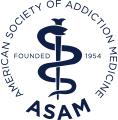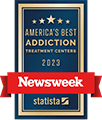Understanding Alcohol Addiction
Learn About Alcohol Abuse & Addiction
The intoxicating substance alcohol can be found within beer, liquor, and wine, and is the most commonly abused substance within the country. While it is often just referred to as “alcohol”, the substance itself is actually ethyl alcohol, which comes from the fermentation of starches, sugars, and yeast.
The use of alcohol is included in many practices throughout the United States, including social gatherings, celebrations, and many religious services. A number of people are capable of consuming alcohol responsibly and without suffering negative effects, but for millions of others, the consumption of alcohol leads to significant upset, including the development of alcohol use disorder, or AUD.
The Diagnostic and Statistical Manual of Mental Disorders (DSM-5) states the criteria listed below are indicative of AUD. If an individual meets two of more of the following criteria within a 12-month period, he or she will be diagnosed with AUD:
- Experiencing withdrawal symptoms when one is incapable of consuming alcohol
- Consuming larger amounts of alcohol, or drinking for a longer period of time than intended
- Needing to consume large amounts of alcohol to obtain the desired effect
- Spending large amounts of time obtaining, using, and recovering from alcohol use
- Continuing to abuse alcohol even though the individual knows that his or her use has caused or exacerbated a physical or mental issue
- Experiencing alcohol cravings
- Using alcohol in situations where the individual knows that doing so is physically dangerous
- Being incapable of meeting obligations at school, home, or work because of one’s alcohol abuse
- Limiting or stopping participation in activities because of alcohol use
- Continuing to drink even after experiencing social or interpersonal issues that developed from one’s alcohol abuse
The use of alcohol can lead to a variety of issues in all areas of an individual’s life, and defeating alcohol use disorder can be exceptionally challenging. With the proper treatment, an individual can obtain the help he or she needs to end his or her alcohol abuse, reclaim his or her life, and make changes necessary to live in long-term recovery.
Statistics
Statistics of Alcohol Abuse
The National Institute on Alcohol Abuse and Alcoholism (NIAAA) states that more than eight out of every 10 adults in America have consumed alcohol at least one time in their lives, and that more than 50% of all adults in the country have consumed an alcoholic drink within the past 30 days. The American Psychological Association (APA) reports that roughly 12% of adult men and 5% of adult women will show signs that are in line with a diagnosis of alcohol use disorder each year. Alcohol abuse is the third most common cause of preventable death within the country, with researchers reporting that approximately 90,000 deaths occur each year because of the misuse of alcohol.
Causes & Risk Factors
Causes & Risk Factors of Alcohol Abuse
There are a number of factors that can add to an individual’s likelihood of abusing alcohol and developing an alcohol use disorder, such as:
Genetic: Those who have a first-degree relative like a parent or a sibling with alcohol use disorder have a greater risk of developing the same disorder. Experts approximate that genetics account for 40-60% of the risk related to the development of this disorder. Studies with adopted individuals show that an individual whose birth parents struggled with AUD is 400% more likely to develop this disorder than anybody else, even if their adoptive parents did not struggle with this disorder. Researchers have also found that specific genes can increase or decrease an individual’s chances of developing AUD.
Risk Factors:
- Poor coping skills
- Cultural acceptability of alcohol abuse
- High levels of impulsivity
- Peer abuse of alcohol
- Family history of mental illness
- Family history of alcohol abuse and alcohol use disorder
Signs & Symptoms
Signs & Symptoms of Alcohol Abuse
Below are some of the most common symptoms that can indicate if an individual is abusing alcohol and/or has developed alcohol use disorder:
Behavioral symptoms:
- Reckless risky, and dangerous behaviors
- Unexplained absences from work or school
- Secretiveness regarding whereabouts or activities
- Declining performance in work or school
- Neglecting personal or household responsibilities
- Abandoning or limiting participation in activities
- Needing alcohol to celebrate successes or cope with setbacks
Physical symptoms:
- Tingling or “pins and needles” feelings in toes and fingers
- Slurring speech
- Muscle weakness
- Poor coordination
- Disrupted sleep patterns
Cognitive symptoms:
- Alcohol-related amnesia (also known as blackouts)
- Impaired cognition
- Strong cravings for alcohol
- Inability to make decisions
Psychosocial symptoms:
- Drastic mood swings
- Anger and aggressiveness
- Suicidal ideation
- Depression
Co-Occurring Disorders
Alcohol Abuse & Co-Occurring Disorders
The continued abuse of alcohol can lead to many negative outcomes, including:
- Suicidal ideation
- Damage to the liver, pancreas, and heart
- Depression
- Gastritis
- Homelessness
- Ulcers
- Heightened risk for certain cancers
- Financial problems
- Legal problems, including arrest and incarceration
- Physical injury linked to impaired coordination and/or recklessness
- Social isolation or ostracization
- Job loss and unemployment
- Lowered performance in school or at work
- Family discord
- Strained interpersonal relationships
Effects of Withdrawal & Overdose
Effects of Withdrawal & Overdose From Alcohol
Those who have AUD often go through additional mental health illnesses, including:
- Schizophrenia
- Anxiety disorders
- Depressive disorders
- Bipolar disorders
- Antisocial personality disorder
- Conduct disorder
Effects of Withdrawal and Overdose
Effects of alcohol withdrawal: Long-term dependence on alcohol can cause numerous painful and possibly dangerous symptoms to develop if an individual attempts to stop his or her use. Below are some of those common signs of alcohol withdrawal:
- Seizure
- Nausea
- Hallucinations
- Vomiting
- Anxiety
- Excessive perspiration
- Insomnia
- Increased pulse
- Psychomotor agitation
- Tremors
Effects of alcohol overdose: Alcohol overdose occurs when an individual consumes more alcohol that he or she can handle. Also known as alcohol poisoning, this can be highly dangerous and potentially lethal. Anyone who displays the following symptoms after drinking should receive immediate medical attention:
- Seizure
- Vomiting
- Loss of consciousness
- Confusion
- Slowed breathing
- Impaired coordination and balance
- Clammy and/or bluish skin
- Drop in body temperature







